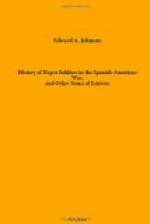“And there is another thing, too, that teaches a man a lesson. The action of the officers on the field is what I speak of. Somehow when you watch these men with their gold braid in armories on a dance night or dress parade it strikes you that they are a little more handsome and ornamental than they are practical and useful. To tell the truth, I didn’t think much of those dandy officers on parade or dancing round a ball room. I did not really think they were worth the money that was spent upon them. But I just found it was different on the battlefield, and they just knew their business and bullets were a part of the show to them.”
* * * * *
NEGRO SOLDIERS.
The Charleston News and Courier says:
It is not known what proportion of the insurgent army is colored, but the indications are that the proportion of the same element in the volunteer army of occupation will be small.
On the basis of population, of course one-third of the South’s quota should be made up of colored, and it is to be remembered that they made good soldiers and constitute a large part of the regular army. There were nearly 250,000 of them in service in the last war.
* * * * *
THE NEGRO AS A SOLDIER—HIS GOOD MARKSMANSHIP—THE FIGHT AT EL CANEY—“WOE TO SPANISH IN RANGE.”
There has been hitherto among the officers of the army a certain prejudice against serving in the Negro regiments. But the other day a Lieutenant in the Ninth Infantry said enthusiastically:
“Do you know, I shouldn’t want anything better than to have a company in a Negro regiment? I am from Virginia, and have always had the usual feeling about commanding colored troops. But after seeing that charge of the Twenty-fourth up the San Juan Hill, I should like the best in the world to have a Negro company. They went up that incline yelling and shouting just as I used to hear when they were hunting rabbits in Virginia. The Spanish bullets only made them wilder to reach the trenches.”
[Illustration: FIRST PAY-DAY IN CUBA FOR THE NINTH AND TENTH CAVALRY.]
Officers of other regiments which were near the Twenty-fourth on July 1 are equally strong in their praise of the Negroes. Their yells were an inspiration to their white comrades and spread dismay among the Spaniards. A Captain in a volunteer regiment declares that the Twenty-fourth did more than any other to win the day at San Juan. As they charged up through the white soldiers their enthusiasm was spread, and the entire line fought the better for their cheers and their wild rush.
Spanish evidence to the effectiveness of the colored soldiers is not lacking. Thus an officer who was with the troops that lay in wait for the Americans at La Quasina on June 24th, said:
“What especially terrified our men was the huge American Negroes. We saw their big, black faces through the underbrush, and they looked like devils. They came forward under our fire as if they didn’t the least care about it.”




